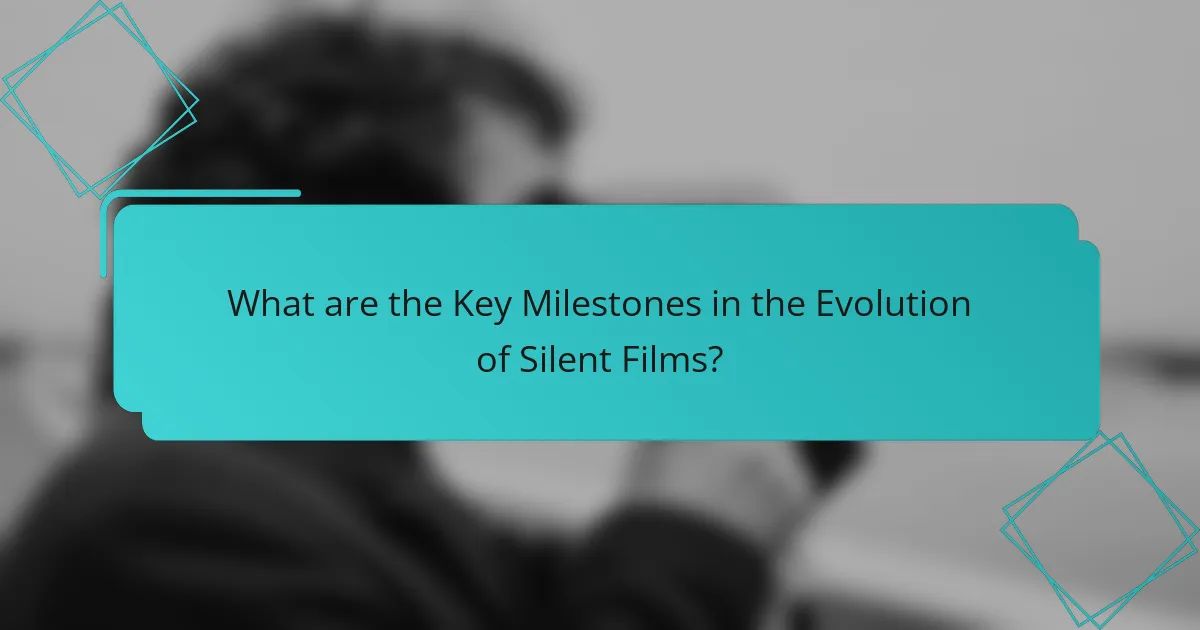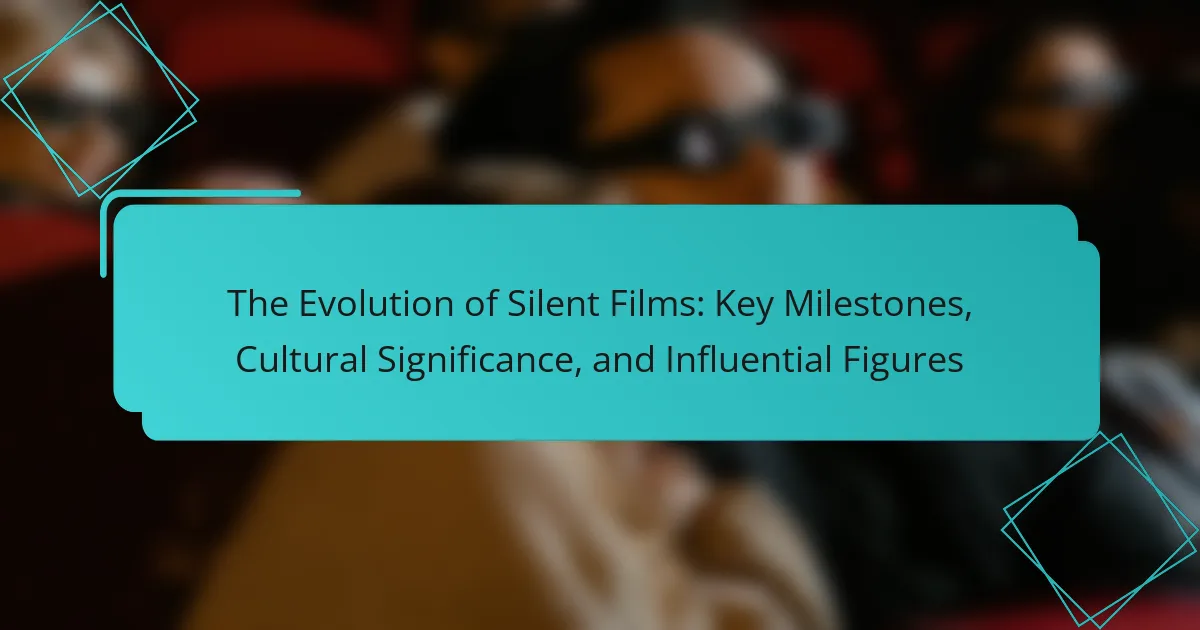The article focuses on the evolution of silent films, detailing key milestones, cultural significance, and influential figures in this cinematic era. Silent films originated in the late 19th century, with early motion pictures created by inventors such as Thomas Edison and the Lumière brothers. Significant developments include the release of “The Great Train Robbery” in 1903 and the emergence of feature-length films like “The Story of the Kelly Gang” in 1906. The article highlights the impact of silent films on modern filmmaking techniques and narrative structures, as well as the contributions of notable figures like Charlie Chaplin and Buster Keaton. Additionally, it addresses the cultural value of silent films and their ongoing relevance in film history and preservation efforts.

What are the Origins of Silent Films?
Silent films originated in the late 19th century. The first motion pictures were created by inventors like Thomas Edison and the Lumière brothers. These early films were short, typically lasting only a few minutes. They featured simple narratives and relied on visual storytelling. The absence of synchronized sound led to the term “silent.” The first widely recognized silent film is “The Great Train Robbery,” released in 1903. This film showcased innovative techniques such as editing and narrative structure. Silent films gained popularity in the early 20th century, leading to the establishment of a film industry. The era lasted until the late 1920s when sound films began to emerge.
How did the technology of filmmaking evolve in the early 20th century?
Filmmaking technology evolved significantly in the early 20th century. The introduction of the motion picture camera allowed for the capture of moving images. Innovations such as the hand-cranked camera and the use of celluloid film improved image quality. The development of synchronized sound technology began in the late 1920s. This led to the creation of “talkies,” which transformed storytelling in cinema. The use of artificial lighting and advanced editing techniques also emerged during this period. By the 1920s, filmmakers utilized techniques like close-ups and montage. These advancements laid the groundwork for modern filmmaking practices.
What were the first films that set the stage for silent cinema?
The first films that set the stage for silent cinema include “The Horse in Motion” (1878) and “The Great Train Robbery” (1903). “The Horse in Motion,” created by Eadweard Muybridge, was pivotal in demonstrating motion through a series of still photographs. “The Great Train Robbery” was one of the earliest narrative films, showcasing editing techniques and storytelling. These films established foundational elements of visual storytelling that influenced the silent film era.
How did early filmmakers overcome the limitations of sound?
Early filmmakers overcame the limitations of sound by utilizing innovative techniques. They employed synchronized soundtracks to match dialogue with visuals. The introduction of sound-on-film technology in the late 1920s significantly improved audio quality. Filmmakers also used live orchestras during screenings to enhance the viewing experience. They creatively adapted storytelling to rely on visual cues and intertitles. The transition to sound films, known as “talkies,” began with successful releases like “The Jazz Singer” in 1927. This film showcased synchronized dialogue and music, demonstrating the potential of sound in cinema. These advancements marked a pivotal shift in filmmaking, transforming how stories were told on screen.
Why were silent films significant in the context of cultural history?
Silent films were significant in cultural history as they marked the birth of the film industry. They introduced visual storytelling to a mass audience. This era spanned from the late 1890s to the late 1920s. Silent films relied on expressive acting and intertitles to convey narratives. They democratized entertainment, making it accessible to diverse audiences. Iconic figures like Charlie Chaplin and Buster Keaton emerged, influencing future generations. The transition to sound in the late 1920s reshaped the industry but did not diminish the impact of silent films. They laid the groundwork for cinematic techniques still used today.
What role did silent films play in shaping societal norms and values?
Silent films significantly influenced societal norms and values during their era. They served as a reflection of contemporary social issues and cultural dynamics. The portrayal of gender roles, for example, often depicted women in both traditional and progressive lights. This challenged existing perceptions and promoted discussions about women’s rights and independence. Additionally, silent films highlighted class disparities and racial stereotypes, shaping public attitudes towards these issues. The rise of film stars created new ideals of beauty and success, impacting societal aspirations. Overall, silent films acted as both a mirror and a mold for the values of their time, contributing to the evolution of cultural standards.
How did silent films influence other art forms?
Silent films significantly influenced other art forms by introducing visual storytelling techniques. They emphasized the importance of visual expression over dialogue. This shift encouraged artists in painting and theater to explore more abstract and symbolic representations. The use of exaggerated [censured] expressions and body language in silent films inspired performers in dance and physical theater. Additionally, silent films contributed to the development of montage techniques, which influenced modern visual arts and photography. The emotional depth conveyed through visuals in silent films also impacted literature, prompting writers to adopt more vivid imagery. Overall, silent films laid the groundwork for the evolution of narrative techniques across various artistic disciplines.

What are the Key Milestones in the Evolution of Silent Films?
The key milestones in the evolution of silent films include several significant developments. The first milestone was the creation of the first motion picture, “Roundhay Garden Scene,” in 1888. This film was directed by Louis Le Prince and lasted only two seconds. The introduction of the Kinetoscope by Thomas Edison in 1891 allowed individual viewers to watch short films. The Lumière brothers debuted their Cinematographe in 1895, enabling public screenings of films. The first feature-length silent film, “The Story of the Kelly Gang,” was released in Australia in 1906, running over an hour. The establishment of Hollywood as a film hub occurred in the 1910s, leading to the rise of major studios. The silent film era reached its peak in the 1920s with iconic films like “The Cabinet of Dr. Caligari” and “The Birth of a Nation.” The transition to sound films began with “The Jazz Singer” in 1927, marking the end of the silent film era. Each of these milestones played a crucial role in shaping the history and development of silent films.
What innovations marked the transition from early to classic silent films?
The transition from early to classic silent films was marked by several key innovations. The introduction of narrative storytelling significantly enhanced film structure. This allowed for more complex plots and character development. The use of intertitles became common, providing dialogue and context. Innovations in camera technology improved film quality and visual storytelling. The development of editing techniques, such as cross-cutting, allowed for more dynamic storytelling. Additionally, the use of synchronized music and sound effects enriched the viewing experience. These innovations collectively transformed silent films into a more cohesive and engaging art form.
How did the introduction of narrative storytelling change silent films?
The introduction of narrative storytelling transformed silent films by providing a structured plot and character development. This shift allowed filmmakers to convey complex emotions and themes. Silent films primarily relied on visual cues and title cards for storytelling. With narrative techniques, filmmakers could engage audiences more deeply. The use of story arcs created a more immersive experience. This change also encouraged the development of genres, such as drama and comedy. Iconic silent film directors like D.W. Griffith pioneered these narrative methods. His work, particularly in “The Birth of a Nation,” showcased how storytelling could enhance cinematic impact.
What were the major technological advancements during the silent film era?
The major technological advancements during the silent film era include the introduction of film stock, the development of motion picture cameras, and the use of editing techniques. Film stock, made from flexible celluloid, allowed for longer and more durable recordings. Motion picture cameras evolved from simple devices to more sophisticated models, enabling filmmakers to capture continuous motion. Editing techniques, such as cross-cutting and montage, enhanced storytelling by allowing the juxtaposition of scenes. The advent of synchronized sound technology, though limited, marked a significant step toward integrating audio with visual storytelling. These advancements laid the groundwork for the future of cinema.
Who were the influential figures that shaped the silent film industry?
The influential figures that shaped the silent film industry include D.W. Griffith, Charlie Chaplin, and Buster Keaton. D.W. Griffith is known for pioneering narrative techniques in films like “The Birth of a Nation” and “Intolerance.” Charlie Chaplin became famous for his character, the Tramp, and his ability to blend humor with social commentary. Buster Keaton was celebrated for his physical comedy and innovative stunts in films such as “The General.” These figures significantly impacted storytelling and filmmaking techniques during the silent film era. Their contributions helped lay the foundation for modern cinema.
What contributions did directors like D.W. Griffith make to silent cinema?
D.W. Griffith significantly advanced silent cinema through innovative narrative techniques. He introduced cross-cutting, which allowed simultaneous storytelling across different locations. This technique enhanced dramatic tension and viewer engagement. Griffith also pioneered the use of close-ups, emphasizing actors’ emotions and reactions. His film “The Birth of a Nation” (1915) showcased these techniques on a grand scale. It was one of the first feature-length films, running over three hours. Griffith’s work laid the foundation for modern filmmaking practices. His contributions shaped the language of cinema and influenced countless filmmakers.
How did actors and actresses impact the popularity of silent films?
Actors and actresses significantly impacted the popularity of silent films through their performances and star power. Their ability to convey emotion without dialogue captivated audiences. Iconic figures like Charlie Chaplin and Mary Pickford became household names. Their unique styles and personas drew viewers to theaters. The public’s fascination with these stars created a demand for more silent films. The marketing of films often highlighted these actors and actresses. This strategy increased ticket sales and expanded the audience base. Their influence helped establish the film industry as a major entertainment medium.

What is the Cultural Significance of Silent Films Today?
Silent films hold significant cultural value today as they represent the origins of cinema. They showcase the evolution of storytelling through visual means. Silent films influenced modern filmmaking techniques and narrative structures. Iconic figures like Charlie Chaplin and Buster Keaton shaped comedic styles still relevant today. They also reflect the social and political contexts of their time, providing historical insights. Film preservation efforts highlight their importance in film history. Events like silent film festivals celebrate their ongoing relevance. Overall, silent films remain a foundational aspect of cinematic art and culture.
How do silent films continue to influence modern cinema?
Silent films continue to influence modern cinema through their storytelling techniques and visual styles. They relied heavily on visual expression due to the absence of synchronized sound. This emphasis on imagery paved the way for modern filmmakers to explore visual storytelling. Techniques such as close-ups and creative editing originated in the silent film era. Directors like D.W. Griffith established narrative structures that are still in use today. The use of intertitles in silent films influenced dialogue pacing in contemporary films. Additionally, the emotional expressiveness of silent film actors set a precedent for performance styles. The legacy of silent films is evident in the works of modern directors who draw inspiration from their innovative approaches.
What themes from silent films are still relevant in contemporary storytelling?
Themes from silent films such as love, conflict, and human emotion remain relevant in contemporary storytelling. Silent films often conveyed deep emotions without dialogue, relying on visual storytelling. This approach is mirrored in modern films that prioritize visual cues and expressions. The theme of love transcends time, appearing in various forms in today’s narratives. Conflict, whether internal or external, drives stories in both silent and contemporary films. Human emotion is a universal theme, resonating with audiences regardless of the era. Additionally, the use of symbolism in silent films influences contemporary filmmakers. For instance, visual metaphors are commonly used to convey complex ideas today. Overall, these enduring themes demonstrate the timeless nature of storytelling across different mediums.
How are silent films preserved and appreciated in modern culture?
Silent films are preserved through various methods, including digital restoration and archiving in film libraries. Many institutions, like the Library of Congress, maintain extensive collections of silent films. These films are often restored to their original quality using advanced technology. Appreciation for silent films is fostered through film festivals dedicated to this genre. Events such as the San Francisco Silent Film Festival showcase restored classics and attract audiences. Additionally, educational programs teach the historical significance and artistry of silent films. Scholars publish research on silent cinema, contributing to its academic appreciation. Silent films are also featured in modern media, enhancing their visibility and relevance today.
What lessons can filmmakers learn from the silent film era?
Filmmakers can learn the importance of visual storytelling from the silent film era. Silent films relied heavily on physical expression, gestures, and visual cues to convey emotions and narratives. This era demonstrated that strong imagery can communicate complex ideas without dialogue. Filmmakers should focus on crafting compelling visuals to engage audiences. The use of intertitles in silent films also highlights the value of concise storytelling. These short texts provided context and clarity, teaching filmmakers to balance dialogue and visuals effectively. Additionally, the silent film era emphasized the significance of pacing and timing in storytelling. Filmmakers can study the rhythm of silent films to enhance their narrative flow. Overall, the silent film era serves as a reminder of the power of non-verbal communication in cinema.
How can the techniques used in silent films enhance storytelling today?
Techniques used in silent films can enhance storytelling today by emphasizing visual storytelling and non-verbal cues. Silent films relied heavily on [censured] expressions, body language, and visual symbolism to convey emotions and narratives. This approach encourages filmmakers to focus on imagery and composition, creating a more immersive experience for audiences. For example, the use of exaggerated gestures can effectively communicate character emotions without dialogue. Furthermore, silent film techniques often utilize pacing and timing to build tension and deliver impactful moments. This method can lead to a more engaging and dynamic storytelling style in modern cinema. Historical examples, such as Charlie Chaplin’s work, demonstrate the lasting influence of these techniques on contemporary filmmakers.
What best practices can be derived from the silent film industry’s evolution?
Best practices derived from the silent film industry’s evolution include focusing on visual storytelling. Silent films relied heavily on visuals to convey emotions and narratives. This emphasizes the importance of strong imagery in any form of media. Another practice is the use of intertitles for clarity. Intertitles effectively communicated dialogue and plot points, ensuring audiences understood the story. Additionally, collaboration among filmmakers, actors, and musicians was crucial. This teamwork fostered creativity and innovation in storytelling techniques. Finally, embracing audience feedback shaped future productions. The silent film era demonstrated that understanding viewer preferences can enhance engagement and success.
The main entity of the article is the evolution of silent films, which encompasses key milestones, cultural significance, and influential figures within the genre. The article outlines the origins of silent films in the late 19th century, highlighting early innovations and notable works such as “The Great Train Robbery.” It discusses technological advancements, narrative storytelling, and the impact of silent films on societal norms and other art forms. Additionally, the article examines the contributions of prominent filmmakers and actors, the ongoing relevance of silent films in modern cinema, and best practices that can be derived from their evolution.
